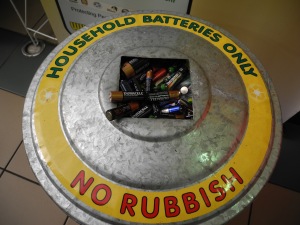After participating in the Zero Waste Challenge, I’ve had a few people comment on the small amount of food waste we have going into our green top bin. Over the seven weeks of data collection, all we discarded was cooked chicken bones (and a handful of olive pips that should have gone into the compost).
Other than the simple strategy of only buying the food that we need, any kitchen waste from preparing meals goes into either our worm farm, compost bins, or the Bokashi bin. I can share our experiences using these over the next few blog entries. For now, I thought I’d start at the kitchen bench and show the system we use to manage our kitchen waste.
 The two small tubs are for the compost bin (left) and worm farm (right). I think the worm farm tub was originally a treat from Scutti’s (so there’s an excuse if you need one).
The two small tubs are for the compost bin (left) and worm farm (right). I think the worm farm tub was originally a treat from Scutti’s (so there’s an excuse if you need one).
There are some raw fruit and vegetable scraps that the worms can’t have and we also don’t put cooked food in the worm farm. Worms don’t like citrus (orange, lemon, grapefruit) and onion (including garlic and spring onions) so all of those go into the compost tub. The worms get all other vegetable and fruit peelings and cores. The tub is usually filled when we prepare the evening meal so it goes straight out to the worm farm near the back door.
Besides the remaining citrus and onion waste, the dark water in the bottom of the compost tub is grounds washed out of the coffee plunger. We used to put these in the worm farm but they added too much water and the grounds clogged the drain tap on the worm farm. I’ll cover that when I describe the worm farm.
The tubs are small enough to use on the kitchen bench but large enough to fit the peelings for preparing the evening meal. If preparing a roast dinner fills the bin several times over with vegetable peelings, it just means a couple of trips to the worm farm.
The Bokashi bin digests the meat and fat trimmings so these are carried straight to the Bokashi, dropped in, and covered with a layer of the Bokashi enzyme powder and the lid re-sealed. The two vegetable tubs can sit on the kitchen bench half full between lunch and dinner but the Bokashi waste has to be disposed of immediately. If we’re busy, sometimes the waste heading to the Bokashi goes into a container in the fridge until we’re ready to open the Bokashi.



